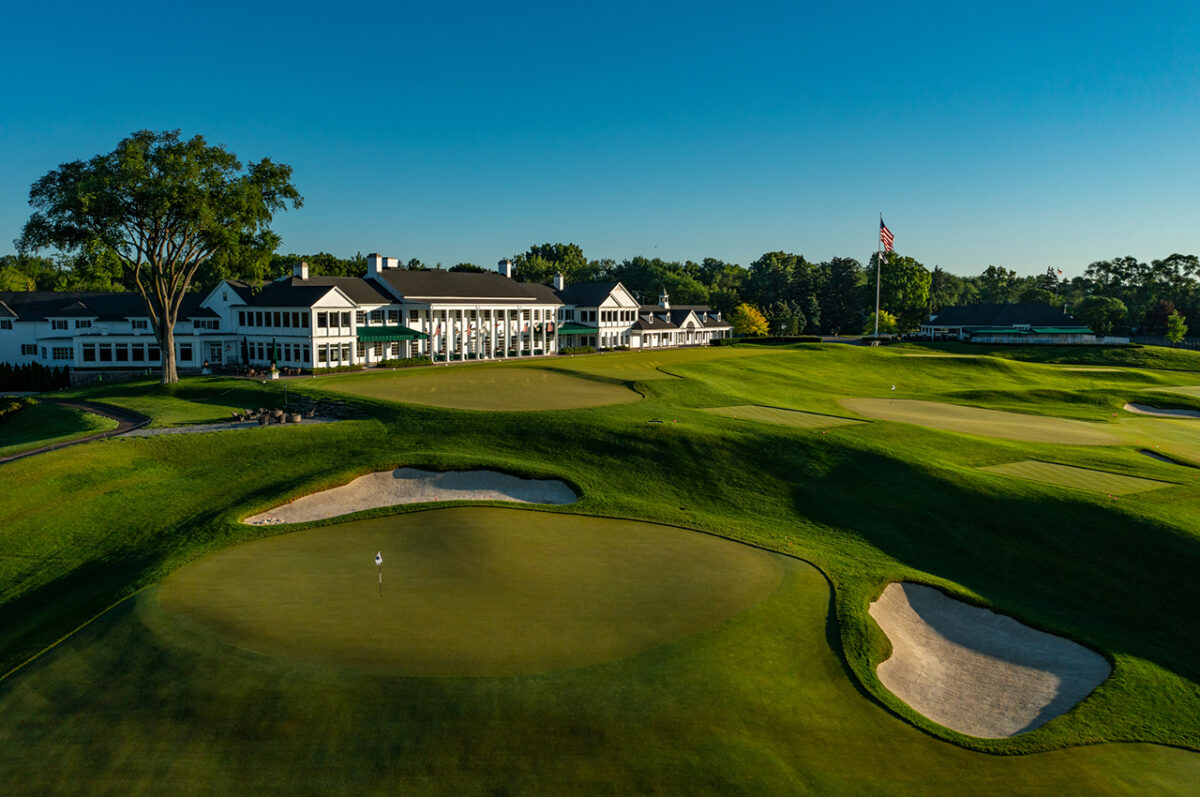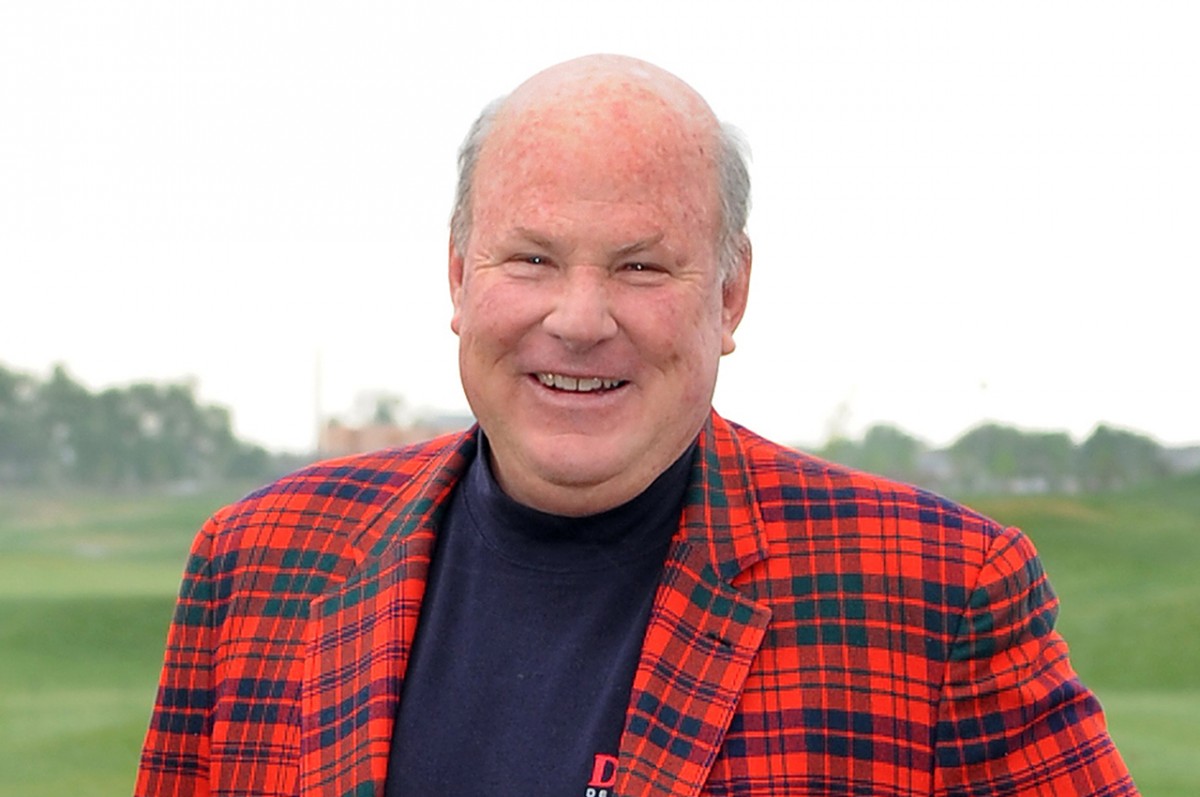BLOOMFIELD HILLS, Mich. – When golf course architect Gil Hanse has time to play golf these days, he abides by his three-strike rule.
“If it’s cold, windy and rainy I’m out,” he said. “If it’s two of the three, I’m OK.”
On a warm July summer day near Detroit, Hanse managed to squeeze in nine holes at famed Oakland Hills Country Club, fresh off a $12 million restoration he led with design partner Jim Wagner and onsite coordinator Kye Goalby, son of Masters champion Bob Goalby. With its testing doglegs, sea of sand and some of the trickiest undulating greens, Ben Hogan nicknamed it “the monster.”
Hanse chuckled when asked to reveal his score. He noted that whenever he and Wagner turn up to play one of their courses, the superintendent always picks the hardest flags on the course. Nevertheless, Hanse was pleased with making five bogeys and four pars before Mother Nature intervened. And yet that nine-hole score perfectly illustrates how Hanse has stiffened the test for the better player while making Oakland Hills more playable and therefore more fun for the average golfer.

“That’s the magic sauce,” Hanse said. “That’s what all of us architects are trying to do. The level of precision required to play the golf course is fairly low. There are wide openings to the greens where you can run the ball where you couldn’t before but we made the fairways narrower where Tour players hit it, or where there are bunkers.”
Oakland Hills, which was founded in 1916 and counts Walter Hagen as the club’s first professional, always has been considered one of golf’s great cathedrals. Even before the restoration, the South ranked as No. 2 in Michigan on Golfweek’s Best Private Courses list. It also is tied for No. 23 on Golfweek’s Best Classic Courses list for all layouts opened before 1960 in the United States. This is land that original designer Donald Ross once proclaimed, “The Lord intended it to be a golf course.”
It gained a reputation as one of the toughest tests of golf after Robert Trent Jones Sr., sharpened its teeth ahead of the 1951 U.S. Open. In the first round, Hogan bogeyed five of the first nine holes and shot an opening 4-over 76 to dig himself a hole but rallied with a final-round 67, at the time the competitive course record, and famously said, “I brought this course, this monster, to its knees.”
That was the first of six U.S. Opens the club hosted, but none since 1996. Oakland Hills was the site of the 2004 Ryder Cup and Padraig Harrington’s victory at the 2008 PGA Championship, but it is one of the worst-kept secrets in golf that this latest renovation was green-lit with the objective of being awarded a seventh U.S. Open and with ambitions of becoming the USGA’s Midwest rota choice for years to come.
When Oakland Hills hosted the 2002 U.S. Amateur – won by Ricky Barnes in a flowery Hawaiian-print shirt that hangs in the clubhouse – technology advances to the driver and golf ball had given players the upper hand. Bill Haas shot a 29 in match play and members were none too happy to read headlines in the local papers proclaiming, “The Monster has lost it teeth.”
Rees Jones, son of RTJ Sr., had inherited his father’s moniker as the Open Doctor, and was called in to bring The Monster back to life. He narrowed fairways and added steeper bunkers, but in doing so made the course a test where an aerial approach of long, high and straight was required. Steve Brady, director of golf at Oakland Hills for 24 years, said that the course was still a bucket-list item for architecture buffs, but golfers crossed it off and didn’t want to come back. It was too hard and, dare one say, boring. When members asked Brady if he’d like to play with them, he’d check which course they were playing – Oakland Hills’s sister course is the North Course, a Donald Ross dating to 1924 – and if they said the South he’d answer, “I’ve got a thing.”
Hanse and his team returned The South to Ross’s original intent, a course that both asks and allows the golfer to consider myriad options to get at a flag. With the exception of the short par-3 13th, every hole provides some front-door entry for a running shot. The course is far more interesting and, by design, more fun for the membership.
“The best architecture doesn’t dictate to the player how they are going to play the golf course,” Hanse said. “When it becomes singular and one dimensional, it’s not great architecture.”
Later, during the same conversation Hanse added: “This game is supposed to be fun, right? We learned a valuable lesson from Mark Parsinen when we did Castle Stuart. He said, ‘Keep the average golfer hopeful and engaged.’ ”
This latest restoration began in the fall of 2019, a 21-month project, to unlock the original design features laid out by Ross. Archived aerial photos and original plans, along with a program from the 1929 U.S. Women’s Amateur, allowed them to get the details right and lent scale and perspective.
[listicle id=778165409]
“It became our bible,” Hanse said of the tournament program. “Kye Goalby probably knows by memory every word of that 1929 program. I think he put it under his head when he went to bed.”
All 18 greens were restored to their original size and shape while constructing them to USGA specifications. Precision Air sub-surface units were installed to control moisture and temperature. Bunkers also were restored with new drainage, fairways were restored to their original widths, new irrigation was installed and a significant number of trees were cleared to improve playing conditions and reopen the vistas. Could these measures be the difference maker in scoring Oakland Hill’s next major? Hanse argues in the affirmative.
“I don’t think the litmus test for the USGA or PGA is going to be can it still challenge the best players in the world? If you get the greens firm and rolling and the rough growing, you can host any championship out here. The thing that will be the most interest to them will be the infrastructure changes and the ability to host a championship with a more predictable outcome with relation to conditions,” Hanse mused. “They want to be able to understand how much control do they have over the setup? The infrastructure, the precision air system, the drainage, the bunker liner system, all the things we’ve done will yield a much more predictable outcome if we have a bad weather week.”
To that point, Hanse said that every green has at least three restored hole locations bringing the severely undulating green complexes front and center as the primary challenge again. Short or long shots now experience the classic Ross table-top runoffs. This will give championship setup committees the options it prefers.
“Can they dictate the way the golf course is presented to the players?” Hanse said. “If there’s only three hole locations, they’re stuck. If more, they can ratchet it up if playing too easy or back off if too hard.”

One of the most notable enhancements is the return of the seventh hole’s putting green to its original location, along with the original size of the creek, which bisects the par 4. It looks like it’s been there all along, and has been widely praised by the membership as the course’s most popular new-old feature.
Some of the improvements are more subtle. Landing areas were made larger – Hanse removed 10 bunkers on the second hole and 15 trees at the eighth and another 23 at the 11th – most notably at the par-4 16th, which was widened by 30 yards. En route to winning the 1972 PGA Championship, Player pushed his drive into the right rough about 150 yards from the lakeside green. He had a stand of willow trees in his way, but he gambled and hoisted a 9-iron to 4 feet. The signature shot of the championship earned a plaque at the spot of the shot. The willows, planted in the 1950s to create The Monster, are no more and today Player’s drive would have rested 10 yards into the fairway.

“That avenue of play was taken away unless you were Player. We felt like stripping away the evolution was another way of letting golfers decide the club. Longer shot, less water, but now the golfer has the freedom (to choose their angle of attack),” Hanse said.
The removal of superfluous trees – crimson, silver and Norway maples, Siberian Elms, Ohio Buckeyes, Honey Locusts, ash, birch, pines, spruces and sycamores – opened up site lines and allowed the club’s iconic neo-colonial white clubhouse that stands on the crest of a hill to be viewed from the most distant spots.
Asked to highlight one of his own touches he left on the famed layout, Hanse didn’t hesitate. “Hopefully nothing,” he said.
He delivered on his promise to make Oakland Hills stand out enough that it should deserve strong consideration to be awarded its seventh U.S. Open while making the course more playable for the members. The USGA’s Jeff Hall, Jason Gore, John Bodenheimer and Mark Hill, the key decision makers in evaluating future sites, all have visited to see the changes. What they found was a kinder, friendlier, more strategic course, but still every bit a monster. And one that is all dressed up and ready for its next major.
[mm-video type=playlist id=01es6rjnsp3c84zkm6 player_id=01evcfxp4q8949fs1e image=https://golfweek.usatoday.com/wp-content/plugins/mm-video/images/playlist-icon.png]




